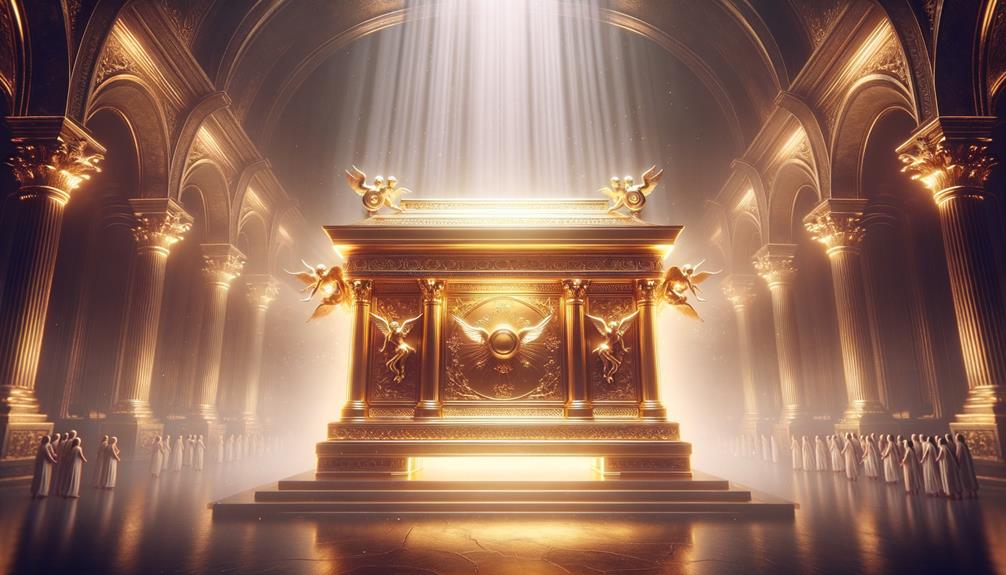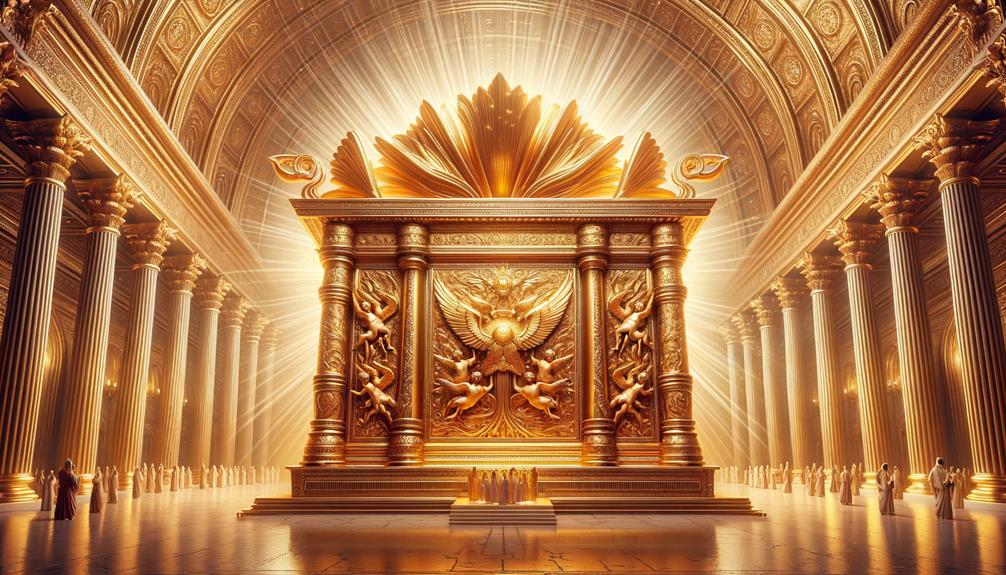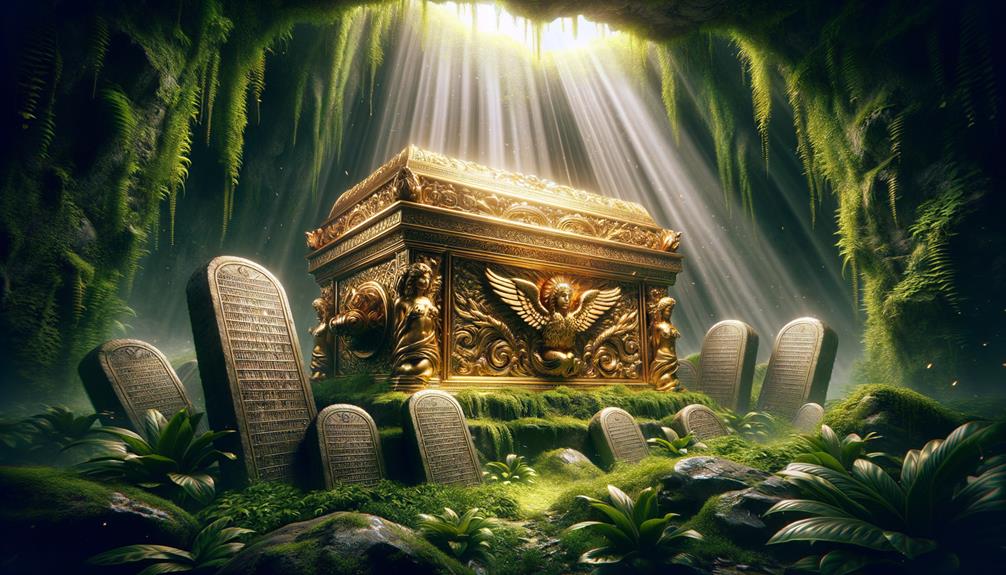The Ark of the Covenant—a sacred chest crafted by Bezalel—transcends its physical form. More than a historical relic, it represents humanity’s profound connection to the divine. Imagine this ancient vessel, a symbol of laws and divine protection, guiding the Israelites through the wilderness, instilling hope when faith wavered. Its spiritual legacy extends beyond its journey, continuing to inspire our search for meaning and divine presence.
While the Ark’s historical significance intrigues, its true power comes from the timeless spiritual connection it represents. This revered object’s influence endures, challenging us to contemplate our values and beliefs. Its mystique captivates, reminding us that even amidst life’s uncertainties, symbols can unite and elevate our human experience.
Construction and Design
The Ark of the Covenant‘s construction from Exodus showcases intricate design and symbolism. Bezalel, blessed with divine expertise, meticulously followed God’s blueprint, utilizing acacia wood and gold – materials representing purity and permanence, reflecting the Ark’s sacred nature.
Measuring two and a half cubits long, one and a half wide, and one and a half high, the Ark’s exterior and interior glistened with pure gold overlay, underscoring its divine significance. Rings and poles allowed transportation without direct contact, preserving holiness.
Atop the Ark rested the mercy seat, adorned with outstretched golden cherubim wings, symbolizing God’s protective presence among the Israelites. Every construction detail reinforced the Ark’s monumental role in the covenant between God and His people.
Symbolism and Meaning

Unpacking the Ark of the Covenant reveals a tapestry of powerful symbols spanning generations. More than just a sacred object, it embodied God’s covenant with the Israelites and His enduring presence among them. Crafted from acacia wood and adorned with gold, the Ark represented divine guidance, protection, and affirmation.
At its heart, the Ark housed the Ten Commandments tablets, manna, and Aaron’s rod—items profoundly symbolic. The tablets laid out God’s laws and moral code for the Israelites. The manna illustrated God’s provision, while Aaron’s rod signified divine authority and miracles.
The design elements amplified the Ark’s significance further. The mercy seat with flanking golden cherubim served as God’s throne from where favor and judgment were bestowed. There, the Israelites encountered God’s presence through worship and sought His counsel.
Through rich symbolism, the Ark of the Covenant transcended being just a relic. It became a wellspring of hope, a testament to divine love, and a cornerstone of the Israelites’ spiritual journey.
Historical Events

The Ark of the Covenant played a pivotal role in ancient Israel’s riveting history. At the Battle of Jericho, its presence marked God’s favor, enabling the Israelites’ incredible triumph. This event solidified the Ark’s mythical aura as a symbol of divine backing.
When the Philistines seized the Ark, misfortune befell them, underscoring its sacred power. Recognizing this, they ultimately returned the Ark to the Israelites with offerings, acknowledging its holiness.
King David’s retrieval of the Ark from Kiriath Jearim sparked wild celebrations. His joyous procession, brimming with dance and revelry, brought the Ark to Jerusalem, cementing his status as a unifying hero.
Solomon’s Temple became the Ark’s home, housing the original Ten Commandments tablets. This solidified its centrality in Israelite worship, embodying the covenant between God and His people. Through these remarkable events, the Ark of the Covenant remained an indomitable emblem of God’s presence, profoundly shaping the Israelites’ faith and identity.
Religious Significance

The Ark of the Covenant bears enormous spiritual weight for the Jewish and Christian faiths. For Jews, it represents God’s promises and guidance during the Israelites’ nomadic journey. Christians see it as a precursor to Jesus establishing a new covenant. Beyond religion, the Ark kindles curiosity about its unknown fate and potential archeological rediscovery.
At its core, the Ark symbolizes a profound connection between humanity and the divine. Its legacy interweaves spiritual beliefs with real-world history and human experiences. While the physical Ark has vanished, its profound impact on faith traditions echoes through generations, inspiring wonder and reverence in those who encounter its story.
Modern Perspectives

The Ark of the Covenant continues to fascinate people across the globe, its narrative rooted in Jewish tradition and the Old Testament. This sacred chest housed stone tablets with divine commandments, residing in Jerusalem’s First Temple built by King Solomon. After the Second Temple’s destruction, the Ark vanished, sparking numerous theories on its whereabouts.
Groups like the Ethiopian Orthodox Tewahedo Church and Southern Africa’s Lemba people claim ancestral connections to the Ark, reflecting humanity’s profound spiritual yearning. Popular culture amplifies its mystique through films like ‘Raiders of the Lost Ark‘ and novels about the Knights Templar.
From Jerusalem to rumored resting places in Europe, the quest for the Ark mirrors our eternal search for divine understanding, echoing ancient heroes’ journeys. Its allure transcends religious lore, symbolizing humanity’s universal desire for connection with the sacred.
Frequently Asked Questions
What Does the Bible Say About the Ark of Covenant?
The Ark of the Covenant holds profound significance in the Bible. This sacred chest guided the Israelites through their journey, serving as a tangible reminder of God’s presence. Its tale echoes timeless narratives of sacred quests and divine protection.
The ark played a central role, accompanying the Israelites as they wandered the desert. At critical moments, its presence offered strength and reassurance. This enduring symbol resonated with the people, representing their covenant with the Almighty.
Even today, the ark maintains its mystique. While physical evidence remains elusive, its symbolic power still captivates the faithful. Tales of the ark unveil our human yearning for the sacred and our innate need for divine guidance in life’s arduous journeys.
Where Is the Biblical Ark of the Covenant Today?
The location of the fabled Ark remains a tantalizing mystery that sparks intrigue across the globe. Some speculate it lies hidden in the Ethiopian highlands, while others point to secretive corners of Europe. Each theory invites curious minds to ponder the profound symbolism encapsulated in ancient relics and the allure of long-guarded divine secrets. This enigma challenges our preconceptions and beckons us to seek truths that have eluded many for centuries.
Has the Ark of the Covenant From the Bible Been Found?
The Ark’s incredible journey remains shrouded in mystery, fueling ongoing searches and tales akin to heroic quests overcoming countless trials. Despite extensive efforts, its whereabouts remain unknown, sparking endless speculation and unearthing profound revelations about ancient history and faith along the way.
How to Carry the Ark of the Covenant Scripture?
Transporting the ancient Ark of the Covenant was a sacred ritual restricted to the Levites, chosen to uphold reverence. Using wooden poles slotted through rings on the sides, they bore its hallowed weight with utmost care and respect for this religious treasure.


